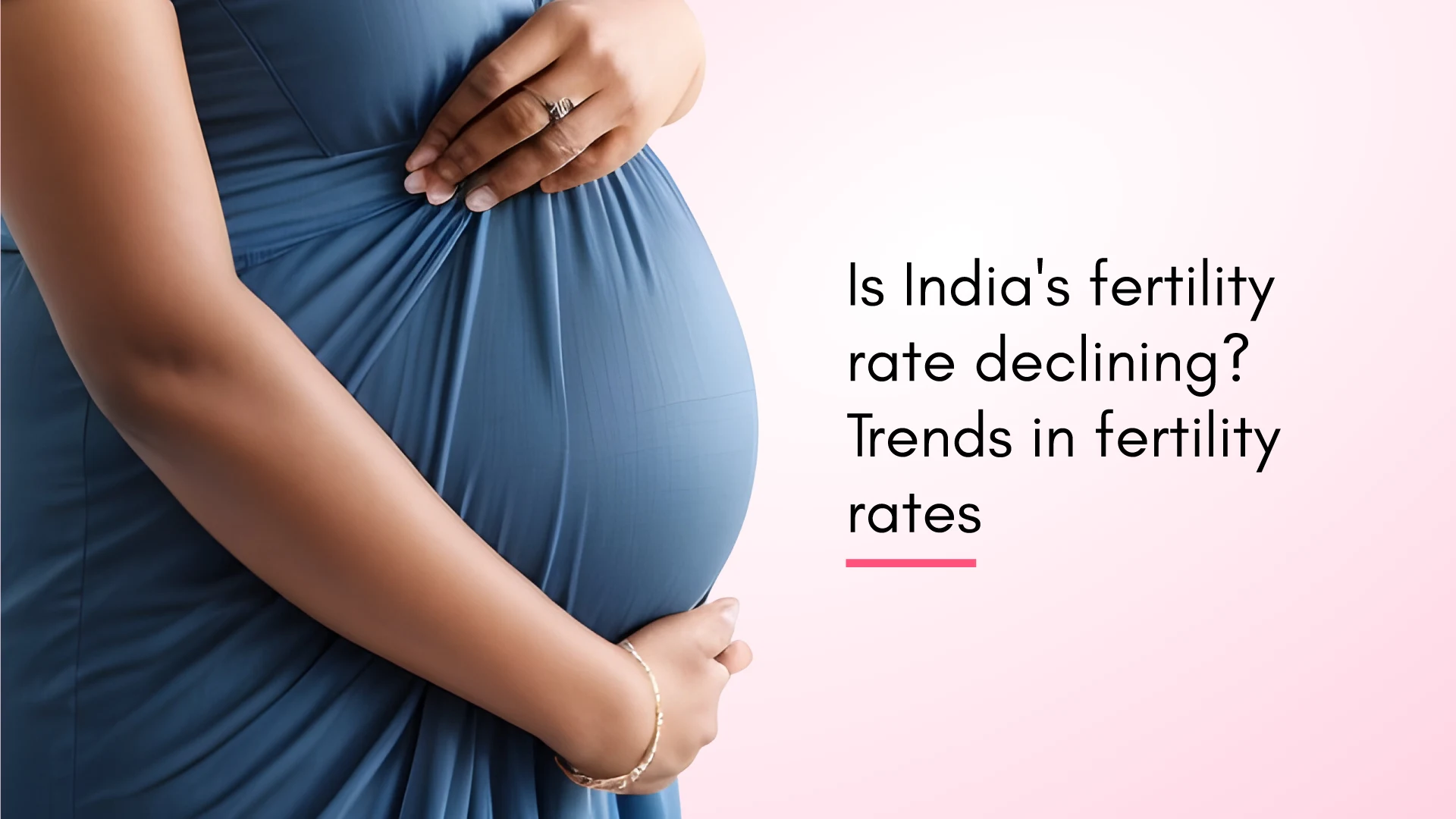What is the Total Fertility Rate?
The total fertility rate (TFR) is a crucial demographic indicator that measures the average number of children a woman would have during her reproductive years, assuming that age-specific fertility rates remain constant. It is a significant metric for assessing population growth and projecting future population trends.
In simple terms, the TFR represents the number of children a woman would bear if she experienced the current age-specific fertility rates throughout her childbearing years (typically between the ages of 15 and 49). A total fertility rate of 2.1 is considered the replacement level fertility, where a population substitutes itself from one generation to the next without experiencing growth or decline.
Also Read: Did You Know 1 in 6 People Globally Are Affected by Infertility?
Also Read: Is Male Fertility Higher or Lower Compared to Female Fertility?
Current Fertility Rate in India
Related Read: The Impact Of Age On Fertility
Causes of Declining Fertility Rate in India
The decline in India’s fertility rate can be attributed to many factors, including government initiatives, social and economic changes, and shifts in cultural norms and attitudes towards family planning. These are:
Post-Independence Family Planning and Welfare Initiatives
The National Family Planning Program, introduced in 1952, played an elementary role in providing access to contraceptive services and education. Over the years, the program has evolved and expanded, offering a range of contraceptive options and counseling services to couples across the country.
Enhancements in Maternal and Child Health:
Improvements in maternal and child health services have also contributed to declining fertility rates. Better access to prenatal medical care, skilled birth attendants, and postnatal care has reduced infant and maternal mortality rates, which has encouraged couples to have fewer children.
Government initiatives like the Janani Suraksha Yojana (JSY) and the Pradhan Mantri Surakshit Matritva Abhiyan (PMSMA) have significantly improved maternal health outcomes and promoted institutional deliveries.
Shifts in Behavioural Patterns:
Changing societal norms and attitudes towards family size have also influenced fertility rates in India. As education levels have risen, particularly among women, there has been a growing awareness of the benefits of smaller families, including improved quality of life, better educational opportunities for children, and financial stability.
Changes in Intergenerational Wealth Transfer:
Traditionally, in many parts of India, children were seen as a source of economic support and security for their parents in old age. However, this perception has shifted with the rise of nuclear families, increased urbanization, and the availability of social security systems.
Parents now prioritize investing in their children’s education and well-being rather than relying on them for financial support in their later years.
Empowerment of Women:
Women’s empowerment through education, employment opportunities, and greater decision-making power within households has played a significant role in lowering fertility rates. As women gain more control over their reproductive choices and have better access to family planning measures, they are better equipped to make informed decisions about the number of children they wish to have.
Adoption as a Family Planning Option:
While adoption is not a direct cause of declining fertility rates, it has become an increasingly accepted option for couples who are unable or choose not to have biological children. The availability of legal adoption services and the growing awareness of adoption as a viable alternative to childbearing have provided couples with an additional family planning choice.
Suggested Read: Why is Fertility Tourism on the Rise in India?
Comparing India’s Fertility Rate with Global Trends
India’s fertility rate decline is part of a global trend, as many countries worldwide have experienced similar patterns. According to the United Nations World Population Prospects record, the global total fertility rate has fallen from 5.0 live births per woman in 1950-1955 to 2.5 in 2015-2020.
Developed countries, such as Europe and North America, have generally experienced lower fertility rates, often below the replacement level of 2.1. In contrast, many developing countries in Africa and parts of Asia have higher fertility rates, although they, too, are experiencing a gradual decline.
Also Read: Male Infertility Rates in India
Consequences of Lowering Fertility Rates
A declining fertility rate generally signifies socio-economic development, but it also poses several challenges that need to be addressed, such as:
Demographic Challenges:
A sustained low fertility rate can lead to an aging population, where the proportion of older adults increases relative to the working-age population. This demographic shift can strain social security systems, healthcare resources, and economic productivity.
A declining population can also result in labor shortages, potentially hindering economic growth and development.
Rise in Non-Developmental Expenditure:
As the population ages, there may be an explosion in demand for medical services, pension funds, and other social welfare programs. This can lead to a rise in non-developmental expenditures, diverting resources from investments in infrastructure, education, and other areas crucial for long-term economic growth.
Labor Shortages Threatening Economic Stability:
A declining fertility rate can result in a shrinking labor force, posing economic growth and stability challenges. Industries that depend heavily on manual labor or specialized skills may face shortages, potentially leading to higher labor costs and reduced competitiveness.
Reduced Talent Pool for Innovation:
A smaller population base could limit the available talent pool for innovation, research, and development. It can affect a country’s ability to remain competitive in a rapidly changing global economy driven by technological advancements.
Potential Social Imbalances:
In some cases, a significant decline in fertility rates can lead to social imbalances, such as skewed gender ratios or regional disparities in population distribution. These imbalances can have far-reaching consequences, including increased social tensions and challenges in maintaining social cohesion.
Strategies to Manage Declining Fertility Rates
Governments and policymakers need to consider a range of strategies to mitigate the potential challenges posed by declining fertility rates to minimize the potential challenges posed by declining fertility rates, such as:
Men Need to Share More Household Duties:
Traditionally, women have shouldered an unequal share of household responsibilities, including childcare and domestic tasks. These can discourage women from pursuing career opportunities or having more children.
Encouraging men to take on a greater share of household duties and promoting a more equitable distribution of household responsibilities help alleviate the burden on women and potentially contribute to higher fertility rates.
Revising Economic Policies and Agendas:
Governments may need to review and revise their economic policies and agendas to address the challenges posed by declining fertility rates. This could involve implementing measures to support working parents, such as paid parental leave, affordable childcare options, and flexible work arrangements.
Policies that encourage workforce participation and entrepreneurship among women can also help mitigate the potential labor shortages resulting from a declining population.
Crafting Policies for Ethical and Effective Migration
In some cases, countries may consider implementing policies encouraging controlled and ethical migration to supplement their workforce and address labor shortages. However, such policies must be carefully crafted to respect human rights, promote social cohesion, and align with the country’s long-term development goals.
Also Read: Recent Advances in Fertility Treatment
Find Hope and Solutions for Female Infertility and Male Infertility — Explore Our Comprehensive Services
ICSI Treatment
PICSI Treatment
Fertility Preservation Service
Blastocyst Culture & Transfer Treatment
Conclusion
India’s declining fertility rate is a significant demographic milestone, reflecting the country’s socio-economic progress and various government initiatives’ effectiveness in promoting family planning and empowering women. However, this trend also presents challenges that need to be addressed through proactive policies and strategies.
By fostering an environment that supports working parents, promoting gender parity, and investing in education and healthcare, India can navigate the potential challenges posed by a declining fertility rate while continuing to make strides towards sustainable development and inclusive growth.




























